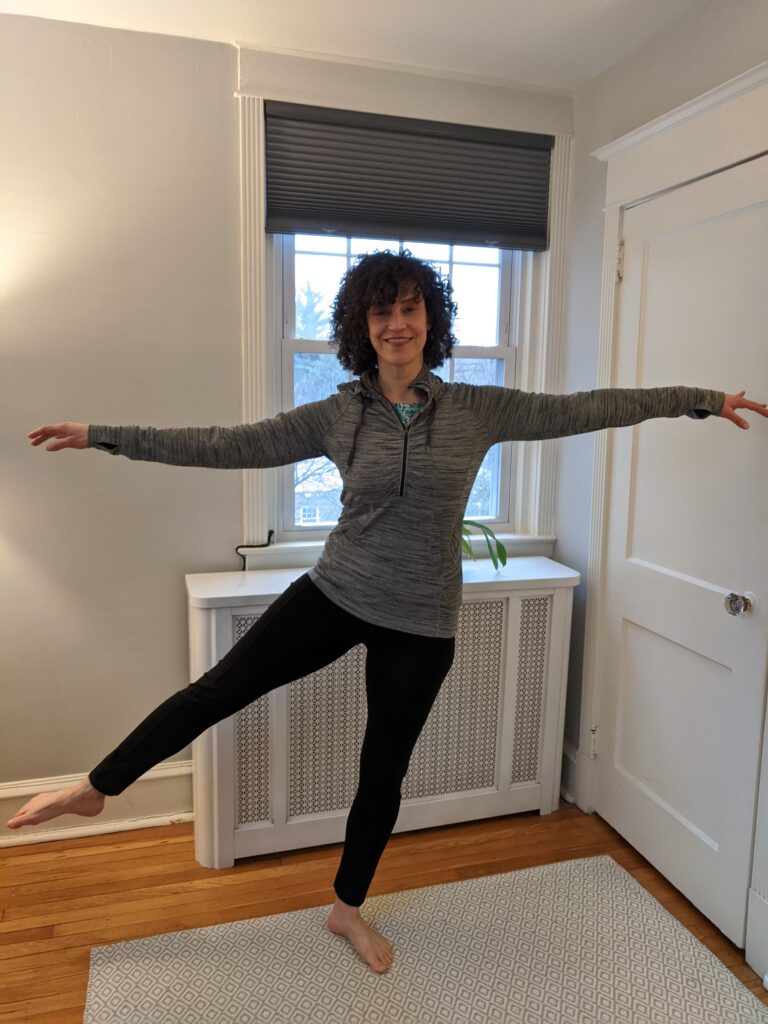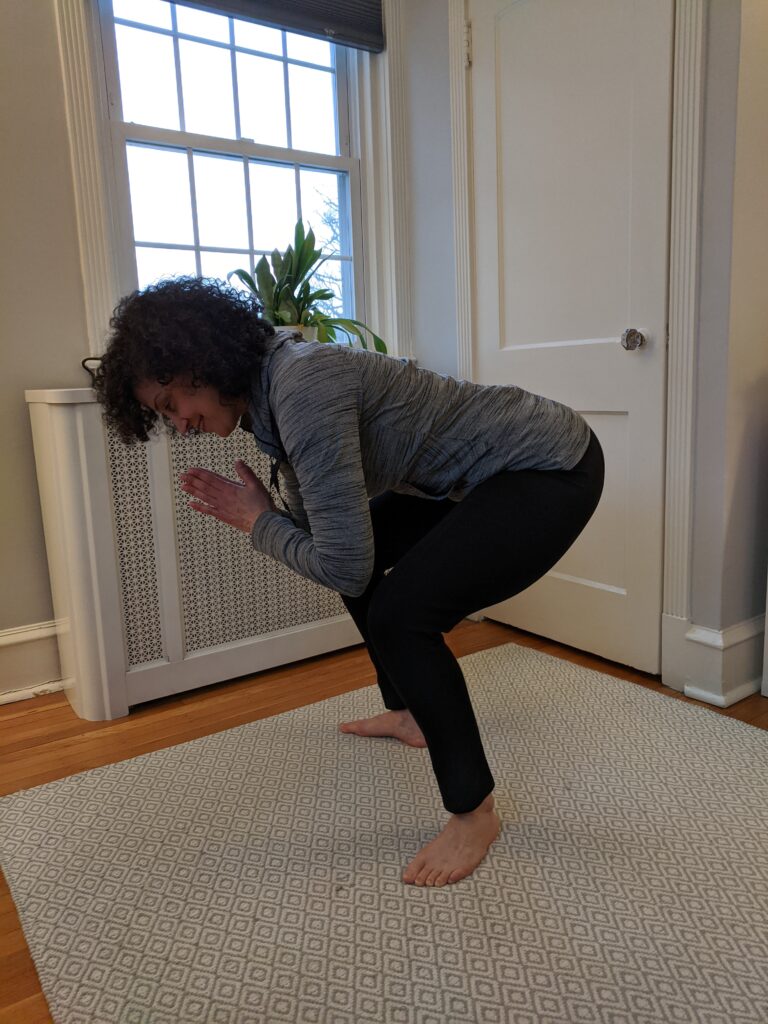As we age, maintaining our balance becomes increasingly important for our overall health and well-being. Good balance can help prevent falls, which are a common cause of injury in older adults.
Our balance gets worse as we get older, but the great news is that we can improve it at any age! Fortunately, there are many exercises that can help improve balance and stability, even for seniors with physical limitations.
The population that I work with is mostly over 60, and I have yet to meet a client who doesn’t want to improve his or her balance. Below are ten easy exercises that are particularly well-suited for seniors.
Whether you are a fitness enthusiast or a complete beginner, these exercises can help you maintain or improve your balance and reduce your risk of falls. So let’s get started!
Balance Exercise #1: One-Leg Stand
The one-leg stand is a simple exercise that can help improve your balance and stability. Here’s how to do it:
- Stand with your feet hip-width apart, arms at your sides
- Slowly lift one foot off the ground, bending the knee and bringing the foot up to your ankle, shin, or thigh. Find a spot to focus on to help with balance
- Hold the pose for as long as you can, up to 30 seconds. Keep your core engaged and your body upright
- Return your foot to the ground and repeat on the other side
If you want to make this easier, try holding onto a chair or wall for support. You can also start with a lower leg hold (i.e. ankle), and progress to higher as you build strength and balance.
If you are more advanced and want to make this harder, here are a few options:
- Close your eyes or try doing the exercise on a softer surface, such as a foam pad
- Turn your head from right to left, up and down
- Increase the hold time, up to one minute or longer
- Move your arms in different directions/patterns
- Have a game of catch with yourself! Toss a ball and catch it or bounce a ball against the wall and catch it
There are several benefits to doing this exercise. It can strengthen your ankles, calves, and thighs, improve your balance and stability, and helps to prevent falls.
If you don’t wish to start with exercise, a great first step is to stand on one leg as you brush your teeth… guaranteed practice at least twice a day!
Performing the one-leg stand for just a few minutes each day can make a big difference in your overall balance and stability. Give it a try and see how it feels!
Balance Exercise #2: Heel-to-Toe Walk
The heel-to-toe walk is an exercise that can help improve your balance and coordination. Here’s how to do it:
- Find a clear, flat space and stand up straight with your arms at your sides
- Take a step forward with your right foot, placing the heel of your right foot directly in front of the toes of your left foot
- Take a step forward with your left foot, placing the heel of your left foot directly in front of the toes of your right foot
- Continue walking in a straight line, placing the heel of each foot directly in front of the toes of the other foot
If you need to make this easier, go slower and take smaller steps. You could also use a railing, wall, or chair for support.
Conversely, to make it harder, try turning your head side to side or looking up and down as you walk. Another choice would be to walk heel-to-toe backwards.
Besides improved balance and coordination and potentially preventing falls, another benefit to this exercise is that it strengthens your lower body muscles.
The heel-to-toe walk is a simple exercise that you can do almost anywhere. Try adding it to your daily routine and see how it improves your balance and coordination over time.
Balance Exercise #3: Heel Raises
Toe raises are a simple yet effective way to improve balance and strengthen the muscles in your feet, ankles, and calves. Here’s how to do it:
- Stand up straight with your feet shoulder-width apart
- Hold onto a stable object, such as a chair or countertop, for support
- Slowly raise up onto the balls of your feet, lifting your heels off the ground
- Hold this position for a few seconds, then slowly lower your heels back down
- Repeat for 10-15 repetitions. Do 2 sets
Hold onto a stable object for support if this is too difficult at first. Also, don’t raise up onto the balls of your feet too high if you’re feeling unsteady.
If you are more advanced, here are a few tips to make it harder:
- Don’t hold onto a stable object for support.
- Add ankle weights to increase the resistance.
- Move your arms in different directions/patterns.
- Turn your head from right to left, up and down.
- Make it a toe walk! Walk the length of the room on the balls of your feet.
Toe raises can be done anywhere with a little bit of space. I love to use heel raises when I teach students and clients. It is a very powerful exercise and you will build strength quickly when you do these regularly!
As you get more comfortable with this exercise, try lifting your heels higher or holding the position for a longer period of time. You can also add ankle weights to increase the resistance.
Balance Exercise #4: Single Leg Deadlift
The single-leg deadlift is a challenging exercise that helps improve balance and stability in addition to strengthening the muscles in your legs and core. Here’s how to do it:
- Stand on one leg with your knee slightly bent
- Hold a weight in your opposite hand (e.g. if you’re standing on your right leg, hold the weight in your left hand)
- Slowly hinge forward at the hips, extending your free leg behind you for balance
- Lower the weight towards the ground, keeping your back straight and your core engaged
- Return to the starting position by engaging your glutes and hamstrings
- Repeat for 10-15 repetitions on one side, then switch to the other leg
If this exercise is too challenging, start with no weight or a lighter weight. You could also use a stable object, such as a chair or countertop for support.
If you want to make it harder, use a heavier weight or hold two weights (one in each hand).
Make sure you keep your pelvis stable (avoid twisting your hips) and your spine neutral (not rounded). Keep your core engaged and only go as low as you can control. You want to own the movement. This is very functional; we pick things up off of the floor all of the time, as well as challenging and extremely effective!
The single-leg deadlift requires a good deal of balance and stability, so it’s important to start with a lighter weight and work your way up as you feel comfortable. As you get stronger and more stable, you can try using heavier weights or even closing your eyes to challenge your balance even more.
Balance Exercise #5: Side Leg Lift
The side leg lift exercise targets the muscles in your hips and outer thighs, helping to improve your balance and stability. Here’s how to perform this exercise:

- Stand with your feet shoulder-width apart, arms down at your sides
- Slowly lift one leg out to the side, keeping it straight and your foot flexed
- Maintain good posture as you lift your leg to the side – try not to shift your upper body, stay lifted on the side of the standing leg
- Hold this position for a few seconds, then slowly lower your leg back down to the starting position
Repeat the exercise with the other leg, and aim for 10 to 15 repetitions on each side.
Here are a few additional tips:
- Keep your upper body still and facing forward throughout the exercise
- To help maintain your balance, focus on a stationary point in front of you
- If you find it difficult to lift your leg to the side, start with a smaller range of motion and gradually work your way up
- As you progress, you can add ankle weights or resistance bands to increase the intensity of the exercise
- Remember not to hold your breath throughout the exercise
The side leg lift is a great exercise for anyone who wants to improve their balance and strengthen their hips and outer thighs. With consistent practice, you can help reduce your risk of falls and improve your overall mobility and stability.
As with all exercises, it’s important to start slowly and listen to your body.
Balance Exercise #6: Marching in Place
Marching in place is a simple and effective balance exercise that can be done anywhere. It helps to improve coordination, balance, and strength in the lower body.
This exercise can be done while holding onto a sturdy object or without any support if you are confident in your balance.
Here’s how to do it:
- Stand up straight with your feet hip-width apart and your arms hanging by your sides
- Lift your right knee up towards your chest, keeping your foot flexed
- Lower your right foot back down to the ground
- Repeat with your left leg, lifting your left knee up towards your chest and lowering it back down
- Continue to alternate lifting your legs, as if you were marching in place, for 30 to 60 seconds
Take a break, and then repeat the exercise for another 30 to 60 seconds.
Here are a few ips for success with this exercise:
- Keep your core engaged and your spine upright (avoid rounding) throughout the exercise
- Lift your knees as high as you comfortably can
- If you need support, hold onto a sturdy object such as a chair or countertop
To make the exercise more challenging:
- Try lifting your knees a little higher or marching faster
- Try swinging your arms to get your heart rate up!
And don’t forget to take full breaths!
Incorporating marching in place into your daily routine is a great way to improve your balance and lower body strength. This exercise is perfect for seniors who are looking for a simple, low-impact way to stay active and improve their balance.
Balance Exercise #7: Chair Squats
Chair squats are an excellent way to strengthen the legs and improve balance. They can be performed using a regular chair, and they are perfect for seniors who are just beginning to exercise or those who have limited mobility.
To perform a chair squat:
- Stand in front of the chair with your feet hip-width apart
- Slowly lower your body by bending your knees and pushing your hips back, as if you were about to sit down in the chair
- Keep your weight on your heels and your knees directly over your ankles. Be sure not to let your knees extend beyond your toes
- Lower yourself as far as you comfortably can, and then stand back up, using your leg muscles to push yourself up
- Repeat the exercise for 10-15 repetitions.

As you get stronger, you can increase the number of repetitions or hold a small weight in your hands to add resistance.
Chair squats not only help to improve balance but also strengthen the muscles in your legs and lower body, making it easier to perform everyday activities. It’s essential to perform this exercise in a slow and controlled manner. Rushing through this movement can increase the risk of injury.
Remember to breathe throughout the exercise and to take breaks as needed. If you experience any pain or discomfort, stop the exercise immediately.
Balance Exercise #8: Weight Shift
Shifting your weight can help improve balance and stability by shifting your weight from one foot to the other. Here are the instructions for how to do it:
- Stand behind a sturdy chair with your feet hip-width apart and your hands resting on the back of the chair
- Shift your weight to your left foot, lifting your right foot off the ground slightly
- Hold this position for a few seconds, then slowly lower your right foot back to the ground
- Repeat the same movement on your right foot, lifting your left foot off the ground slightly and holding for a few seconds before lowering it back down
- Continue shifting your weight from one foot to the other for several repetitions.
Here are a few additional tips to help you perform this exercise well:
- Keep your abdominal muscles engaged and upright posture throughout the exercise to maintain balance
- Start with small weight shifts and gradually increase the amount of time you hold each position
- Focus on shifting your weight slowly and steadily to avoid losing your balance
For a variation on this, try closing your eyes while you perform the weight shifts to challenge your balance even further. Or, for an added challenge, lift your foot slightly higher off the ground or increase the number of repetitions.
If you are using a chair while doing the weight shifts, make sure it is stable and secure before starting. Also, if you have mobility or balance issues, perform this exercise near a wall or sturdy surface to help support you in case you lose your balance.
Balance Exercise #9: Knee Extensions
Knee extensions are a great way to strengthen the muscles around the knee joint and improve balance. This exercise can be performed while sitting in a chair or lying down. Here’s how to do it:
- Sit in a chair with your feet flat on the ground and your back straight
- Lift your right foot off the ground and straighten your leg out in front of you. Hold for a few seconds, then slowly lower your foot back down to the ground
- Repeat with your left foot
Continue alternating legs for a set of 10 repetitions on each side.
For an added challenge, place a resistance band around your ankle and anchor the other end to the leg of the chair. This will provide extra resistance as you lift your foot.
Make sure to keep your movements slow and controlled, and focus on upright seated posture throughout the exercise.
Knee extensions can help to strengthen the quadriceps muscles in the front of the thigh, which are important for maintaining balance and stability. This exercise can also be helpful for individuals who have had knee surgery or who are experiencing knee pain.
Balance Exercise #10: Standing Balance

As you might have guessed from the name, this exercise is great for improving balance and stability! Here’s how to perform it:
- Start by standing with your feet shoulder-width apart and your arms at your sides
- Lift your right foot off the ground and balance on your left foot
- Hold this position for 10-30 seconds. If this is too difficult, start with just a few seconds and gradually work up to 30 seconds
- Lower your right foot to the ground and repeat on the other side
You can make this exercise more challenging by closing your eyes or standing on a pillow or foam pad. Here are a few other tips:
- Make sure you have something nearby to hold onto in case you lose your balance
- Focus on a point in front of you to help with balance
- Engage your core muscles to help with balance
- Breathe deeply and evenly while holding the position
It’s important to do this exercise regularly to see improvement in your balance. Start with a few repetitions and gradually work up to 10-15 repetitions on each side.
The Importance of Balancing Exercises for Seniors
Incorporating balance exercises into a regular fitness routine can greatly benefit seniors, as it can improve balance, stability, flexibility, cardiovascular health, cognitive function, and mood while reducing the risk of falls and chronic conditions.
Staying active and incorporating regular exercise into one’s routine can be challenging, especially for seniors who may face physical limitations or other barriers. However, the benefits of regular exercise are numerous and can greatly enhance one’s overall health and well-being.
These 10 easy balance exercises are a great starting point for seniors who want to improve their balance, and can be done in the comfort of their own home or as part of a group exercise class.
Improve your confidence and your activity level by incorporating balance work into your daily program! If you are interested in joining a group class, or working with me privately to tailor a program that can improve your balance and is tailored to your individual needs, please don’t hesitate to get in touch!
Get back to a life that moves you!
